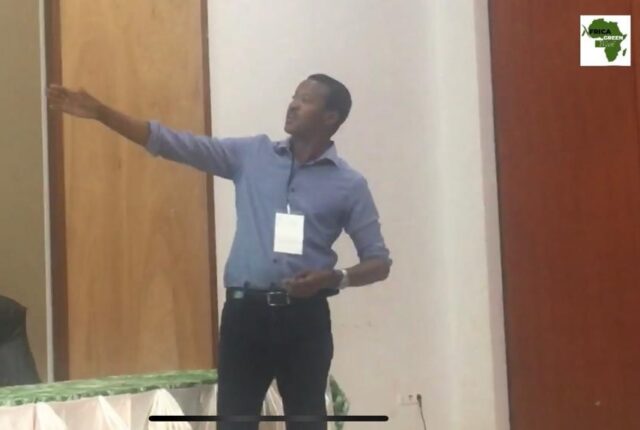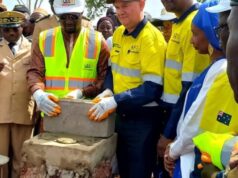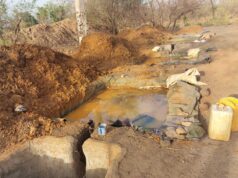The first edition of Africa Green Week, held in Bobo Dioulasso from 11 to 14 October 2023, focused on a number of mining-related topics. Kalid Kéré, Chairman of the Corporate Social Responsibility (CSR) Forum, spoke to participants on the theme of “Environmental management in mining companies: CSR approaches and best practices”.
In his speech, the President of the CSR Forum, Kalid Kéré, pointed out that Corporate Social Responsibility (CSR) was originally seen as a philanthropic action in the 1950s. It evolved to be seen in the 1990s as companies’ contribution to sustainable development. As far as the definition of CSR is concerned, he notes that its content varies from one institution or state to another.
In Burkina Faso: “An organisation’s responsibility for the impact of its decisions and activities on society and the environment, reflected in transparent and ethical behaviour that contributes to sustainable development, including the health and well-being of society; takes into account the expectations of stakeholders; complies with applicable laws and international standards of behaviour; and is integrated throughout the organisation and implemented in its relationships”, Kalid Kéré.
The Chairman of the CSR Forum was quick to point out that CSR in the mining sector also has to do with environmental impact, technological information, human and institutional capacity building, and so on.
The State monitors and regulates
The presenter of the day pointed out that CSR depends on the areas in which companies operate. As far as environmental management is concerned, through their environmental management system (EMS), mining companies have policies on environmental protection and sustainable development, environmental monitoring plans on air quality, water points, vibrations, noise emissions, etc. They also have plans for waste management, biodiversity and site rehabilitation. They also have plans for waste management, biodiversity and site rehabilitation. For its part, the government monitors and regulates environmental and social impact assessments (ESIAs) and environmental and social management plans (ESMPs) for mines. Quarterly and annual activity reports are produced by the mines and filed with the government. A regular audit of the environmental management system is carried out, environmental inspection missions are organised by the ministries responsible for mines and the environment, and the mines contribute to the environmental rehabilitation fund.
Best practice
In terms of good practice, he presented the case of the grove within the mining perimeter of the Bagassi mine, operated by Roxgold and now by Fortuna.
The implementation of the mining project required the felling of almost 5,000 trees. The mine has therefore committed to developing a reforestation programme throughout the life of the project. The ESMP provides for the successful planting of nearly 5,583 trees. Each year, a reforestation campaign is launched in collaboration with the local communities. In the end, more than 55,000 trees have been planted since the project began. In terms of impact and results, the survival rate of plant species is over 80%. The species planted include forest species (Acacia nilotica, Adansonia digitata, Moringa olifera, Parkia biglobosa) and fruit species (Mangiefera indica, Citrus limon, Anacardium occidentale). These species take into account those felled during the implementation of the project and the needs expressed by local people. The conclusions show a clear evolution of vegetation in the compensated zone and a repopulation of the conservation zone.
The second good practice comes from the Essakane mine through its “Iron Fund” set up in 2016. This project is based on the auctioning of scrap metal from its scrap yard. The proceeds from the sale of this scrap metal are used to finance development projects benefiting communities in the area directly impacted by the mine. Eligible projects include environmental awareness campaigns. From 2016 to 2020, 176 projects have been funded to the tune of 200 million FCFA, mainly benefiting young people and women, with very good results. The sale of iron residues is a sustainable financing alternative for community projects.
Kalid Kéré concluded by pointing out that, at national level, there are many challenges to be met in order to increase the mining sector’s contribution to environmental protection, in particular the practical experience of closing the generation of mines that are due to close by 2030. Internationally, the coming years will see many changes in the mining sector, as global organisations and financial markets see decarbonisation as both a requirement and a responsibility for mining organisations. In addition, mining companies are under increasing pressure from various stakeholders to reduce their emissions in order to mitigate climate risk. It has been established that the sector has an important role to play in the energy transition and in accelerating progress towards the Sustainable Development Goals. Hence the commitment of many industry players to decarbonising their activities by 2050 and contributing to the fight against climate change.
Tiba Kassamse OUEDRAOGO
#Mines_Actu_Burkina










